Curtis Edmonds's Blog, page 12
August 9, 2017
Why I Wrote a Picture Book About America in the Age of Trump
There is only one real reason anyone writes a book for children, and that is because they have children who pester them until they do. Or at least that’s what happened to me. I have eight-year-old twin daughters, and they are both avid readers. They know that I’ve written a couple of books for grown-ups, and they are not incredibly happy that they’re not allowed to read them. So they started lobbying me to write a book they could read.
This kind of thing does not always work, of course — I have successfully turned a deaf ear to multiple entreaties to get a dog, or a cat, or a hamster, or an iPhone. And, initially, I was able to deflect request to write a children’s book. “It’s actually harder to come up with a new idea for a children’s book than you think,” I would say. “You also have to illustrate it, and I have no idea how to draw.” I figured that would be enough to defuse the issue.
It might have been, too, except that I was driving the children home one day, and they were prattling to each other, pretending to be different people with different names. “Well, my name is Amanda,” one of them said to the other, and something about that struck home. (Amanda is their main babysitter.) Later that night, I wrote the first couplet for the book:
If my name was Amanda
I’d live in Atlanta
And I’d say hello to a shark.
If my name was Bonnie
Then I’d live in Boston
And catch fly balls in Fenway Park.
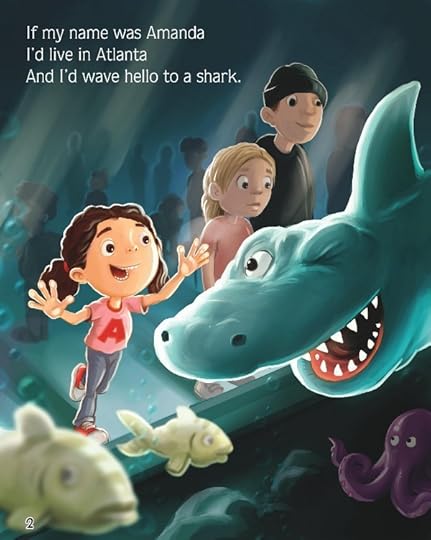
That was the easy part. (The “shark” reference is for the Georgia Aquarium.) Once I had the basic formula established, I had to figure out matching first names and cities for each letter in the alphabet, and then I went back and tried to get the rhymes to work. (I also ended up taking the Fenway Park reference out; I didn’t want to run into any trademark issues if I could avoid them.) After that, I had to get the meter just right, so it would be easy to read. That involved taking the entire text and putting it into a spreadsheet, with a separate syllable for every cell.

Once I got the text finished, and decided that the title should be , it was time to find help with the artwork. I lucked out and found an illustrator on Twitter — an English artist who turned out excellent work at a bargain price. Once I got the artwork put together, then it was time for the acid test — reading the book to the other kids at my daughters’ school. (They liked it, and their teacher was enthusiastic about the book’s use as a classroom aid to American geography.)
But why go through all the trouble to put out a children’s book in a market that’s already glutted with children’s books? There are already, literally, hundreds of rhyming alphabet picture books alone, many of them incredibly well-done and well-known. Why bother with another?
Ultimately, there were three reasons why I persevered and kept the project going.
1. I wanted to write a picture book that kids and parents could both enjoy.
This is sort of a cop-out — who wouldn’t want to write a children’s book that kids and parents can both enjoy? But there are a lot of picture books that don’t make for easy and convenient bedtime reading. Even the esteemed Dr. Seuss wrote Fox in Socks, which is just tongue-twister after tongue-twister; I finally put my foot down and refused to even touch it. I never did figure out why Goodnight Moon was so popular. The nearly-wordless Good Night, Gorilla is lovely, but requires the adult reader to fill in the blanks — and woe betide the tired parent who leaves out a key detail. I wanted my book to be short and concise, and I wanted it to have a simple rhyme pattern with a good rhythm for easy reading, and I think I accomplished that. (My model in this was Sandra Boynton; if you have a very small child in your house, you can’t go wrong with one of her board books for bedtime.)
But I also wanted it to be a book that wasn’t pushing any particular kind of behavior. A lot of children’s books focus on discouraging negative behaviors. We liked the Llama Llama books by the late Anna Dewdney, but they are almost all about how the young character has to learn not to throw tantrums every time something doesn’t go his way. (If that was, in fact, the intent of the books, they have been a spectacular failure at our house.) We also liked the Elephant and Piggie books by Mo Willems, but several of those are behavior-related, too — like I Really Like Slop, which is all about Piggie trying to push “pig culture” on Elephant Gerald (sound it out) by making him try a nasty-looking bucket of slop. I have nothing against any of these books, you understand, but I also didn’t want something with a heavy-handed behavioral message. Kids get that sort of thing all day long; can’t they get the occasional break from it?
2. I wanted to write a picture book that showed that America is more than a collection of strip malls.
I live in a small town in central New Jersey that has a lot of the same big-box retailers and fast-casual restaurant chains that you probably have in your town. I dislike the essential sameness of the suburban outback; when I travel with my kids, I want to try to get away from it as much as I can.

was designed to introduce some of the beauty and majesty of our country to children. It also showcases just how different the different parts of our country are. The young girl who is featured in the story visits beaches and ski slopes, monumental structures and pizza joints, wilderness hikes and urban adventures. In her imagination, she crisscrosses the country from the badlands of South Dakota to a balloon ride over New York. This is a big, interesting, diverse country, and I tried to capture some of that flavor in the book.
3. I wanted to show children a positive vision of America.
One of the most depressing statements of the last decade was Michelle Obama’s declaration that she had not been proud of America until the point that her husband began his Presidential campaign. (One wonders how she feels nowadays.) Akin to that in spirit, although not in content, is Donald Trump’s promise to “Make America Great Again,” which of course implies that America is not great now (and that only Donald Trump can make it great again). Both statements are not only profoundly negative, but depend on the premise that politics — and only politics — can make America more praiseworthy.
What a pathetic lie to tell to children! America is great in spite of her political leadership, not because of it. There is not a whiff of politics in , outside of a background picture of the Capitol dome. That’s because the things that make America great have little or nothing to do with politics.

There are a few political children’s books out there. One of the top-selling rhyming alphabet books on Amazon is a book called A is for Activist, which features a raised fist on the cover. One reviewer says ““Reading it is almost like reading Howard Zinn’s A People’s History of the United States, but for two-year olds.” Charming. Chelsea Clinton published a book in May that riffed off of the rebuke Senator Elizabeth Warren received for criticizing the nomination of Attorney General Sessions; She Persisted: 13 American Women Who Changed the World features profiles of Oprah Winfrey and Sonia Sotomayor, among others. There are a few political children’s books on the Right as well — most notably by Rush Limbaugh.
I want my kids growing up with a sense of pride in our country and our people, unimpaired by political strife — to the extent that such a thing is possible anymore. I wanted to reflect that sense of pride, and to help strengthen it. It’s important for everyone, in spite of our political differences, to recognize that there is a great deal about our country that is worth celebrating, and if one little rhyming alphabet picture book can help do that, I feel like I’ve done a good job.
Curtis Edmonds is the author of IF MY NAME WAS AMANDA (if you haven’t figured that out by now) which is available on and .
June 14, 2017
The Hallelujah Effect
There is a scene in the Captain Underpants movie…
All right. First, let me get this out of the way. I only went to see the Captain Underpants movie because my kids love the books and were dying to see the movie. It is a movie that is (by design) without the slightest appeal to parents, and is only useful for this conversation because of, as I said, this one scene.
So in the Captain Underpants movie, the two elementary-school jokesters that are the heroes of the movie find out a salient fact about their sadistic science teacher. His name is “Professor Poopypants.”
And once they find out this information, a heavenly light shines on them, and the strains of Handel’s Messiah plays, and the two heroes warble the “Hallelujah Chorus,” because they have just been handed the ultimate weapon to use against their tormentors.
What I am calling for the purposes of this essay “The Hallelujah Effect” is essentially a combination of surprise and shock crossed with schadenfreude, the invaluable German word for the joy that one feels at another’s misfortune. It is that moment when your view of the world — whatever view that is, colored by whatever political biases that you have — is vindicated in some alarming way — particularly one that makes your political opponents look bad.
Most people, I expect, have experienced the Hallelujah Effect at one time or another. If you are a Democrat, you may have felt it when the news came out that an intolerant Republican Senator had been caught, literally, with his pants down in an airport bathroom trying to solicit anonymous sex from another man. If you are a Republican, you may have felt it when the news came out about Hillary Clinton’s clandestine e-mail server. The opportunities for the Hallelujah Effect seem to have expanded in recent years — and thanks to the rise of social media, each of us now has a greatly enhanced ability to share our feelings with the rest of the world when the Hallelujah Effect strikes.
And that is almost always a mistake.
A caveat, first. I believe absolutely in the right of free speech. You are of course free to say whatever you like about whatever you like. You are free to engage in horrible forms of speech, like, oh, let’s say, making the sequel to the Captain Underpants movie. I am not going to stop you. But tweeting or Facebooking or commenting on matters political while you are experiencing the Hallelujah Effect is not a good idea, and I hope to dissuade you from doing so, for three reasons.
First, whatever is going on is most assuredly not about you. This is especially true if the event that triggers the Hallelujah Effect is a tragedy. To use the all-too-familiar example of terrorism, when someone detonates a suicide vest at a concert, slaughtering young concertgoers, the issue of whether the terrorist shouted the name of Allah before his dastardly act is not perhaps the most pressing issue. And of course, the terrorist did turn out to be an Islamist, and that may very well validate whatever points out want to make about Islam, or immigration, or radicalization or what have you. But at the moment, what happens in Manchester, or London, or Boston is not about you. You may very well have a perfectly valid opinion that deserves a wider audience. Shut up anyway.
Secondly, you have to realize that the Hallelujah Effect is very often an illusion. If it turns out that the actual facts (as opposed to the reported facts) are different than what you supposed, openly celebrating the Hallelujah Effect in public may prove to be an utter embarrassment. This can occur in spectacular ways, such as the liberal mavens who managed to convince themselves that a Tea Party activist was behind the Arizona shooting that severely injured Representative Giffords, when the actual shooter had no political leanings to speak of. Davy Crockett famously said, “Be sure you’re right, then go ahead.” During Hallelujah Effect moments, the urge to go ahead rather to be sure that one is right can be overwhelming. It is wise to resist it.
Finally, if your purpose is to convince someone else on the other side of the issue that he or she is wrong, well, good luck with that. There is a point to be made, I think, that the increased use of inflammatory and incendiary political rhetoric on the left may have inspired the Alexandria shooter. But even if that was definitely, provably the case (which it is not), pointing this out will not convince even one person on the left that they should change their behaviors. Similarly, I think there is a point to be made that perhaps more could be done to identify potential mass shooters and decrease their ability to obtain deadly weapons. But do you think making that point will change the opinions of any National Rifle Association die-hard? It will not.
This is depressing. Life is depressing — as P.J. O’Rourke reminds us, more depressing than anything except the known alternative. The only corrective that I can suggest is seeking one’s Hallelujah Moments in areas outside of politics.
June 6, 2016
A Small Victory For Adaptive Technology
I took off work today. I am the program manager for the state assistive technology program in New Jersey, where I work with our contractors to help people with disabilities get access to assistive technology devices and services. As a lawyer, I also represent people with disabilities in administrative hearings to try to get them access to durable medical equipment from Medicaid. But I wasn’t doing any of those things today.
I was at my kids’ school, doing Field Day. The way that Field Day works in our school is that you have different stations, and each parent that volunteers is in charge of one station, and explains the game to the kids, and they play it for ten minutes before they grab their water bottles and move on to the next game. My station had two games for the kids to play. One was called “Space Walk,” which involves a sort of curly-W shaped thick wire, which hooks on to two lightweight foam balls at either end. The idea is to balance the contraption on top of your head and walk a short distance, make a U-turn, and go back the other way. All the kids take turns, like in a relay race. The other game was a sack race, also done in a relay.
I’d had two first-grade classes, all of the kindergarten classes, and the pre-K classes all come through. I had figured the next to come through was the remaining first-grade classes. I was wrong. There were about five kids in the next group, all accompanied by an aide.
Special education class, I thought. How come nobody mentioned there was a special education class?
And then, hey, well, of course the special education class is out here on Field Day, it would be much worse if they’d been left inside. You can manage this.
“Okay,” I said. “What they’re supposed to do is walk with these things on their head from here to there.” I took one look at the class. That wasn’t going to happen. I was not about to try to play diagnostician with these kids, but there were some obvious balance and coordination issues going on. It wasn’t going to work.
“You usually have to be a little adaptive,” one of the aides said.
Adaptive, I thought, that’s a word I understand. “Maybe they can try balancing the thing on one hand, like this.” A couple of the kids tried it, but it wasn’t working very well.
I thought back to when I was in elementary school, and what I liked to do, and I came up with an idea. Parachute.
I took the foam balls off the wire thingy, and grabbed one of the sacks for the sack race. “Try this!” I said. I handed one end of the sack to one of the kids, and took hold of the other end, so it was stretched out. Then I dropped the foam balls on top of the sack, and started shaking the sack. “See! It’s kind of like a parachute game.”
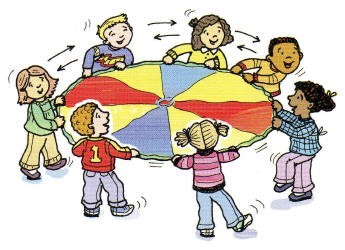
“Good idea,” one of the aides said. She took some more of the foam balls and got her own sack, and had a couple more kids play the parachute game. As the proof of concept had been established, I stepped back and let the aides take over. After about ten minutes, the air-horn sounded, and the kids and the aides went off to the next station.
“That was a really good idea you had,” another of the aides said.
I don’t think this is anything more than a cute story, but it can illustrate a larger truth. We can accommodate students with disabilities, even in nontraditional settings. All it takes is a little imagination, and a willingness to adapt to situations as they occur.
May 11, 2016
LOCK IN, by John Scalzi — the “Horrifying Scenario” Analysis
This is not a book review. I wanted to do a book review for Lock In, by John Scalzi, which is a book that I both think very highly of, on one hand, and which I also think has a couple of serious flaws. The problem is that I try to write book reviews without giving away plot spoilers, and I can’t talk about the single biggest flaw in Lock In without giving away the big spoiler in the book. So this isn’t a book review; it can’t be.
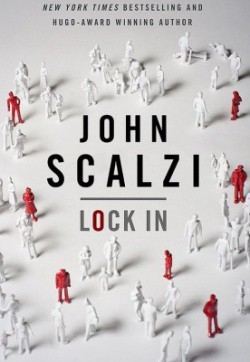
What I decided to write instead of a book review is to talk about the world of Lock In and the (largely unstated) horrifying consequences that would ensue from such a world. This approach assumes that you’ve either read Lock In or are at least willing to listen to a brief synopsis of the plot. WARNING: This discussion contains major spoilers for Lock In. Please do NOT read this if you have any intention of reading the book at a future point.
Horrifying Scenario #1: The Experience Machine
In Lock In, a significant minority of Americans–Scalzi likens it to the population of Kentucky–experience “lock in” as a result of a mutated flu virus that attacks people’s brains. Individuals affected with the “Haden” virus cannot move or blink or even scratch where it itches, which does not sound good. The scope of the Haden infection is so vast that the government spends a trillion dollars on research-and-development to consider what can be done to mitigate the suffering of the locked-in.
What the research comes up with is a four-fold system. First, a surgeon cracks open your head and installs a new neural network (complete with tentacles) that interfaces with your brain. (Scalzi tells us that this can be installed in the brains of the very young, although you’d think that would mess with normal brain development.) The network then transmits your consciousness to your choice of outlets. You can access “The Agora,” which is described as a “three-dimensional social network,” which doesn’t mean anything except pointing out how two-dimensional current social networks are. You can transfer your consciousness to a big clanky robot, colloquially known as a “threep.” Or, you can interface with an “Integrator,” someone who was infected with the Haden virus but not locked-in, who has a similar neural network and is not doing anything on Saturday and is happy to let you use their bodies for a couple of hours for cash.
Each of these aspects of the system has its own horrifying scenarios, but the most philosophical of them deal with the concept of “The Agora.” Scalzi does almost nothing to explain “The Agora,” classifying it all as it’s-a-Haden-thing-you-wouldn’t-understand. Very well then. This leaves the reader free to imagine what it’s like, and what it’s like is probably something close to the Experience Machine. Wikipedia:
[Harvard professor Robert] Nozick asks us to imagine a machine that could give us whatever desirable or pleasurable experiences we could want. Psychologists have figured out a way to stimulate a person’s brain to induce pleasurable experiences that the subject could not distinguish from those he would have apart from the machine. He then asks, if given the choice, would we prefer the machine to real life?
The classic response to this is “no,” or at least “not permanently.” But this is from people who are capable of both being able to respond and to scratch that place behind their knee. Would somebody who was totally locked in want to spend at least some part of their day in an Experience Machine? The answer, unsurprisingly, is HELL and YES.
That positive response is reinforced by two other factors. First, “The Agora” is superior to the Experience Machine in that the Experience Machine is a solo endeavor and “The Agora” seems to be more social, so there’s that. Second, at the end of the book, the protagonist announces a plan to set up a competing version of “The Agora” free from government control, which could make it even more awesome (i.e., free of censorship).
So why is this horrifying?
Scalzi makes the point that the Haden economy is dependent on dwindling government largess, and has to be offset by tax dollars brought in by Haden workers. Fair enough. Medical care for Hadens has to be a really big number (as we’ll see) and it’s got to be offset somehow. If said Haden who is receiving said medical care is on “The Agora” playing an immersive version of Madden 2025 for twenty-four hours a day, that sort of eats into one’s productivity. (Ask me how I know.)
So here’s the question: Given the choice, as a Haden, would you plug into “The Agora” 24/7, or get a job (that is to say, the kind of job you can get as a robot)? In Lock In, the answer seems to be largely up in the air. The protagonist (more on him/her later) lands a job as an FBI agent, and there’s a general strike of all Haden workers that serves as a backdrop. (We’re not told much about what sort of jobs Hadens get in the economy–a lot of them seem to be truck drivers, although we see a doctor and a software developer.) The general strike is a response to the funding cuts for Haden patients, and is part of a political movement for Haden independence (which seems at cross-purposes with the need for more funding but there you go and political movements in fiction don’t have to make perfect sense any more than they do in real life).
If “The Agora” is largely how Scalzi represents it, it may not be much of a question. But if “The Agora” is anything like, say, the OASIS in Ready Player One, where you can hop in your DeLorean and spend the day shooting wamp rats with your proton pack and your nights drinking pina coladas, eating lobster and making love like sea otters, that might be a different story altogether.
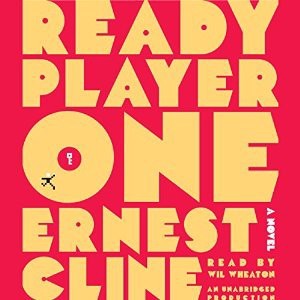
Look, you don’t even have to have a Ready Player One virtual reality universe for this to be a problem. Japan already has an issue with its hikikomori population of young people who don’t work, live off government assistance, and fool around with anime and manga comics all the livelong day–and who don’t have sex or reproduce, cutting into Japan’s fragile birthrate. Could the American economy support caring for multiple millions of helpless people who are spending their time eating virtual bonbons on Planet Hershey?
And that’s just the Haden population. What about everyone else? Scalzi tells us that the non-Hadens can access “The Agora,” but only in restricted settings. If anyone can tune in, turn on, drop out, and spend their days doing (oh, let’s say) Starsky and Hutch virtual cosplay? What does that do to the economy?
 Starsky and Hutch cosplay would be a lot of fun. I am just sayin’.
Starsky and Hutch cosplay would be a lot of fun. I am just sayin’.In Ready Player One, the protagonist is driven past a small camp of homeless people standing around a trash fire, waving around their haptic gloves and staring into their visors, oblivious to the ruined society all around them. In the Lock In world, you wouldn’t even need the visors and gloves — the entire virtual world is hard-wired directly to your brain.
Obviously everyone wouldn’t plug in–but you’d have to think that enough people would, enough to depress the economy and wreck the birthrate.
Horrifying Scenario #2: The Medical Model
A brief aside here.
I am not really qualified to talk about the disability issues in Lock In because I don’t have a disability. Having said that, I’ve got over twenty years of experience as a disability advocate. I run the state assistive technology program in New Jersey. I’ve written four law review articles on the ADA and the Air Carrier Access Act, and two or three scholarly articles on website accessibility. So maybe I’m a little qualified to talk about it a little bit.
Lock In has a scene where its protagonist, Chris Shane, Special Agent of the FBI, transmits his/her consciousness to the Los Angeles FBI office, where he/she is given a defective threep, which he/she is expected to operate by means of a manual wheelchair. It’s not clear as to whether this is meant as a practical joke of some kind or just an outside-the-box way to re-purpose broken equipment. Chris doesn’t comment on this other than dropping the mic and renting a threep from Avis, but the implication is that Chris is rejecting the disability label.
Which is fine. Generally speaking, society doesn’t have an issue when people with disabilities want to be treated like they’re not disabled. You hear that people have “overcome” their disability, or you hear parents bragging that they treated their child with a disability just like any other kid. We’re fine with that sort of thing as a society. Able-bodied people want to think that having a disability is not a big deal, and can be overcome with character and work ethic. (It doesn’t work in reverse: society hates it when able-bodied people park in accessible parking spaces.)
The problem is that, to pull something like this off, it is really helpful to have lots of resources available to you. You might have seen a movie a few years back, The Bone Collector, where a bed-ridden Denzel Washington fights crime–with the aid of about sixty different computer screens and enough processing power to run Cheyenne Mountain. That’s how disability works in Hollywood. And as someone who spends a great deal of his work life trying to get Medicaid to pay for even simple durable medical equipment, I can tell you, Hollywood ain’t real.
 I mean, seriously, look at all this stuff. I have to fight like hell to get Medicaid to pay for any of this crap for my clients, much less all of it.
I mean, seriously, look at all this stuff. I have to fight like hell to get Medicaid to pay for any of this crap for my clients, much less all of it.What Scalzi does here is cheat by giving Chris a set of billionaire parents, who can afford to give him/her a dedicated medical cradle and twenty-four hour care and the latest hot-off-the-assembly-line threep. Which is fine; there are people in society who are rich and obviously their children are going to rate better medical care. Chris may not think of himself/herself as having a disability, but that hardly makes him/her what you would call typical.
So what kind of treatment does the typical Haden get?
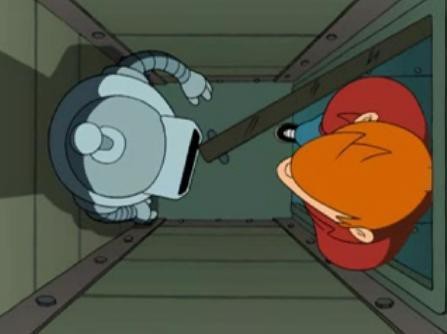 You guessed it.
You guessed it.Scalzi hints at this when he talks about rental properties for Hadens, which are basically closets where their threeps can recharge. (I imagined these as being like Bender’s apartment in Futurama.) But those properties are for the threeps. Where are the bodies?
I don’t know for certain, but I bet they’re in nursing homes, or something worse than nursing homes. I mean, think about it from the perspective of a Medicaid administrator. (You may want to take a shower after you do this.) You have a greatly increased number of patients who need around-the-clock care and monitoring. What’s the cheapest way to do that? Answer: fill up old and disused facilities with Haden patients. The patients are all locked in, so you don’t need to have programming for them, or feed them anything but sludge, or provide clothes or counseling or even sunlight. It would be like The Matrix, but instead of using the patients as batteries you’d use them to collect federal Medicaid dollars. Tell me your average state Medicaid administrator wouldn’t do this in a second. (I would say “in a heartbeat” but, well.)
 Take the red pill, and your federal Medicaid waiver plan is approved. Take the blue pill, and you’ll see just how far the rabbit hole goes.
Take the red pill, and your federal Medicaid waiver plan is approved. Take the blue pill, and you’ll see just how far the rabbit hole goes.There are two competing orthodoxies in disability policy. One is the “civil rights model,” which says that people with disabilities are people and have the right to be free and independent and not to experience discrimination, and sometimes discrimination comes in the form of a stairway or a doorknob or a toilet paper dispenser that’s three inches too high. Then there’s the “medical model,” which says that you have a disability if you meet a certain medical criteria, and if you do, we’re going to do our best to cure you, and if we can’t, well, that’s too bad, here’s some federal benefits and maybe a job at a sheltered workshop or something. What you have in Locked In, largely, is a situation where the civil rights model is ascendant, but only for people who have both a threep and the resources to arrange home care. It doesn’t say what happens to everyone else under the medical model. I don’t think that was good to start off with, and with the severe budget cuts Scalzi describes, it might get worse.
(Oh, and if you don’t think that the mass institutionalization of a large disability subset is ipso facto horrifying, you have my permission to visit a large state psychiatric hospital sometime. Please. I’ll hold the door open for you and everything.)
 Oh, come on. Don’t be a fraidy-cat.
Oh, come on. Don’t be a fraidy-cat.Does Scalzi do a fine job of having a heroic protagonist with a serious disability? Yes, unreservedly. But the only major Haden characters in the book are Chris, a diabolical billionaire and his lackey attorney, a software engineer, a doctor, and a political leader. Maybe that’s not the top 1% of Hadens, but it’s telling that there’s not a representative character who’s in the 99%. I think Lock In handles the disability issues in the book with sensitivity, but it’s clearly not telling the whole story.
Horrifying Scenario #3: The Sexual Aspect
Scalzi goes to great lengths to keep the question of whether Chris Shane is male or female open, going so far as to say that “I personally don’t know Chris’s gender.” I am not going to speculate here on why he made that particular choice. I think it’s simultaneously kind of brilliant and kind of screwy, which is mostly meant as a compliment. I am OK with it in that I think that it’s an idea that progresses naturally from the premises of the novel, as Chris presents to the world as a non-gendered threep. I have very mixed feelings from the disability perspective, as there’s already a social stigma about talking about disability and sexuality together. I dislike that you have a heroic protagonist with a disability who is also genderless–I think that’s problematic.
What’s even more problematic is that Scalzi never, not even once, talks about Haden sexuality.
One of the characters in Lock In is a former Integrator, and according to her, what Haden patients typically do, when they are integrated with an Integrator for the first time, is go to Five Guys and get a bacon double cheeseburger.
 Come to papa.
Come to papa.Now, look. I have nothing against the bacon double cheeseburger from Five Guys. I’d like one myself right about now. I’m from Texas, so I’d rather have a Whataburger, but to each his own. I just don’t think that would be everyone’s first choice. (Even from a gustatory perspective, I’d rather have Texas sheet cake and homemade vanilla ice cream.)
How many people, do you think, would hire an Integrator in order to have sex with their significant others? Or, you know, themselves?
I know what you’re thinking, because I am thinking it too, and I am thinking SQUICK SQUICK SQUICK SQUICK SQUICK. It’s okay. Take a deep breath.
Because I haven’t even gotten to the whole part about robot sex.
 SQUICK SQUICK SQUICK SQUICK SQUICK.
SQUICK SQUICK SQUICK SQUICK SQUICK.OKAY. Calm down.
Look. There are a lot of different sexual scenarios that could, conceivably, come to mind in this particular universe. I think that there is some wisdom, from an authorial perspective, to not exploring them, to leaving them unsaid. (I will point out that Scalzi has had no problem with exploring the group-sex implications of his fictional universe in the Old Man’s War books.) But by making Chris essentially genderless, Scalzi effectively walls off the reader from any discussion of Haden sexuality. (Or, to put it another way, he leaves it to the devices of the masses of fan-fiction writers. Squick.)
Horrifying Scenario #4: The Plague Years
Scalzi just happens to mention, at one point, that people are still getting lock-in, all the time, although not at the levels that were happening at the height of the epidemic. Meanwhile, you never see anyone, you know, wearing a surgical mask, or slathering themselves with Purell, or refusing to go outside, or generally behaving how people would behave if they thought they could catch the Haden flu and be locked in their bodies for the rest of their lives.
I am just throwing this out there.
I know why you have to have normal people running around doing normal things, because otherwise there wouldn’t be a story, but still. You’d think that people would be, you know, a little afraid of catching the flu in this universe. It’s already a paranoid thriller, you’d think that would amp it up a bit.
Horrifying Scenario #5: The Brain Hack
There’s a scene in Lock In where Chris sits in his/her Bat Cave (no, really), as he/she considers all the different suspects in his multiple murder case, and narrows them down to either an influential community organizer or a powerful billionaire titan of industry bent on cornering the market for Haden services.
Who do you think the killer is?
Go on, guess.
You’ll never guess.
Wow! You guessed right. It was the evil billionaire! How did you ever figure that out?
 (Okay, I’m done now.)
(Okay, I’m done now.)This is the horrifying scenario that Lock In spends the most of its time exploring. Can evil billionaires hack your brain and turn you into a zombie assassin? The answer is yes. The problem is that (at the time of the novel) it’s incredibly expensive, and very much an emerging technology, and it’s just as easy to use an Integrator to shoot whoever you want shot. So there’s that.
What else can the technology do? Maybe you don’t want to turn your army of hacked Integrators and threeps into zombie assassins. Maybe you want them all to move to Delaware and vote for you for the open Senate seat. Maybe you want to hack their brains to play the Meow Mix jingle constantly in their brains until they commit suicide. Maybe you want to go seriously old-school Othello and convince someone that their wife is cheating on them until the point where he decides to murder her.
Anyway, point is, lots of things you can do if you can hack into someone’s brain. Including making them write very long blog posts that aren’t book reviews, instead of writing a new novel. Hey, wait.
The Less-Horrifying Conclusion
Lock In is a lot of fun to read and has at least one memorable character in Chris’s partner, who is Lynchian but the wrong kind (Jane and not David). It reads much better as a near-term science-fiction drama (a genre where it excels) than it does as a police procedural (where it largely falls flat). You should read it, and if you’ve read this far, you already have. It has cool zombie assassins and ninja robots. And it makes you think deeply about what the implications of new technology, both medical and robotical, might be for our own future, to the point of writing a long blog post about it that very few people will read. These are all good things, and it is to Scalzi’s credit that he produced a novel that generates such good things.
February 19, 2015
A Song For The Season
I really can’t stay.
Baby, it’s cold outside.
I’ve got to go away.
Baby, it’s cold outside.
This evening has been…
Seriously, it’s very cold out there.
So very nice.
Did you look at the forecast? There’s 50-mile-an-hour winds and stuff, and the roads are a sheet of black ice.
My mother will start to worry.
She has reason to. It’s freezing out.
Father will be pacing the floor.
You know, they have these things called cell phones now. Call him. He’ll be glad to know you’re somewhere safe.
So really I’d better scurry.
You may not even be able to start your car. Seriously. It’s that bad out.
Maybe just a half a drink more.
Sure. Great. I’ll put some hot chocolate in the Keurig.
The neighbors might think.
They’re out shoveling. I saw them.
Say, what’s in this drink?
It’s the dark chocolate K-cup. It tastes a little different. Relax. Look, I’ll put in another pod if you want something different.
I wish I knew how
Knew what?
To break this spell
No. This is totally not seduction I am doing here. Seriously. It is absolutely ridiculously cold out there, and the streets aren’t safe.
I ought to say no, no, no
I mean, it’s up to you, but I’d just hang out here until it calms down. Totally your call.
At least I’m gonna say that I tried
You can say whatever you want. Doesn’t change the fact that there’s a foot of snow in the forecast.
I really can’t stay –
Ah, but it’s cold outside. I am not kidding. Go check if you don’t believe me.
February 9, 2015
No One Catches The Ryan Express
I made a little table that estimates how long a given active pitcher would have to pitch to approach the Nolan Ryan strikeout record. I took the top 50 or so active pitchers, all with at least a thousand strikeouts, and calculated how many strikeouts they would need to tie the Ryan record of 5714 strikeouts, and how long it would take them to do that if they (incredibly unrealistically) averaged 200 strikeouts a year, every year, with no serious injury. (This includes some recent retirees who are technically listed as active on the Baseball Reference site.)
This table makes it clear (as if anyone doubted it) that only King Felix and Clayton Kershaw have even the foggiest chance of catching Ryan, and that it will take them twenty years to do that if they do.
It’s depressing, really. Take a look at Justin Verlander–he’s done everything a pitcher can or should aspire to do, he’s done it for ten years, and he’s going to have to pitch until he’s fifty, pitching more strikeouts per year than he’s averaged so far, to catch up with Nolan Ryan. Or take Stephen Strasburg–because of his injuries, he’s only got 746 K’s, which means it’s going to take him 25 years to catch up to Ryan, and that’s as long as he’s been alive on this planet.
I think, really, the only way that anyone in this generation catches up to Ryan would be if CC Sabathia learned the knuckleball and managed to pitch until he was half a century old. But come on.
Current Rank
Pitcher
Seasons Pitched
Age
Total Strikeouts
Distance Behind Ryan
Seasons to catch up (averaging 200K/year)
Age when caught up
8
Felix Hernandez
10
28
1951
3763
18.815
46.815
26
Clayton Kershaw
7
26
1445
4269
21.345
47.345
1
CC Sabathia
14
33
2437
3277
16.385
49.385
17
Cole Hamels
9
30
1707
4007
20.035
50.035
23
Matt Cain
10
29
1506
4208
21.04
50.04
18
Zack Greinke
11
30
1687
4027
20.135
50.135
19
Tim Lincecum
8
30
1644
4070
20.35
50.35
11
Justin Verlander
10
31
1830
3884
19.42
50.42
36
Yovani Gallardo
8
28
1226
4488
22.44
50.44
43
David Price
7
28
1147
4567
22.835
50.835
28
Max Scherzer
7
29
1321
4393
21.965
50.965
50
Gio Gonzalez
7
28
1072
4642
23.21
51.21
25
Jon Lester
9
30
1457
4257
21.285
51.285
5
Jake Peavy
13
33
2027
3687
18.435
51.435
29
Scott Kazmir
10
30
1319
4395
21.975
51.975
22
Ervin Santana
10
31
1507
4207
21.035
52.035
32
Ubaldo Jimenez
9
30
1288
4426
22.13
52.13
10
Dan Haren
12
33
1881
3833
19.165
52.165
52
Chad Billingsley
8
29
1037
4677
23.385
52.385
35
Edwin Jackson
12
30
1227
4487
22.435
52.435
20
James Shields
9
32
1626
4088
20.44
52.44
27
Jered Weaver
9
31
1405
4309
21.545
52.545
41
Francisco Liriano
9
30
1184
4530
22.65
52.65
47
Matt Garza
9
30
1127
4587
22.935
52.935
9
Josh Beckett
14
34
1901
3813
19.065
53.065
55
Anibal Sanchez
9
30
1037
4677
23.385
53.385
39
Ricky Nolasco
9
31
1191
4523
22.615
53.615
7
Johan Santana
12
35
1988
3726
18.63
53.63
2
A.J. Burnett
16
37
2370
3344
16.72
53.72
30
Adam Wainwright
9
32
1306
4408
22.04
54.04
31
Oliver Perez
12
32
1300
4414
22.07
54.07
12
Cliff Lee
13
35
1824
3890
19.45
54.45
13
John Lackey
12
35
1790
3924
19.62
54.62
15
Mark Buehrle
15
35
1779
3935
19.675
54.675
4
Ryan Dempster
16
37
2075
3639
18.195
55.195
54
Francisco Rodriguez
13
32
1005
4709
23.545
55.545
42
C.J. Wilson
10
33
1149
4565
22.825
55.825
16
Aaron Harang
13
36
1734
3980
19.9
55.9
24
Kyle Lohse
14
35
1504
4210
21.05
56.05
49
Joe Blanton
10
33
1086
4628
23.14
56.14
6
Tim Hudson
16
38
2016
3698
18.49
56.49
14
Randy Wolf
15
37
1786
3928
19.64
56.64
34
Erik Bedard
11
35
1246
4468
22.34
57.34
37
Wandy Rodriguez
10
35
1209
4505
22.525
57.525
44
Jason Marquis
14
35
1137
4577
22.885
57.885
46
Chris Capuano
10
35
1134
4580
22.9
57.9
21
Bronson Arroyo
15
37
1526
4188
20.94
57.94
33
Brad Penny
14
36
1273
4441
22.205
58.205
51
Joel Pineiro
12
35
1058
4656
23.28
58.28
3
Bartolo Colon
17
41
2101
3613
18.065
59.065
45
Bruce Chen
16
37
1136
4578
22.89
59.89
40
Jamey Wright
19
39
1189
4525
22.625
61.625
48
R.A. Dickey
12
39
1089
4625
23.125
62.125
A Study In Comparisons
This is one of the oddest things I have ever written, but it’s been a lot of fun to think about and now I have to share it with the world. What this is, for better or for worse, is a one-on-one comparison between the 2016 Presidential contenders (and a few others) and selected National Football League teams.
I told you it was odd.

The Democrats

Hillary Clinton reminds me of the New England Patriots, just a little bit. The Patriots, at heart, are an uneasy partnership between a talented, charming quarterback (Bill) and a shadowy mastermind in unfashionable clothes (Hillary). The Patriots, like the Clintons, have had the longest unbroken record of success in the game (with the glaring exception of the Patriots’ Super Bowl losses to the Giants / the 2008 loss to Obama, and more about him later). It’s already being whispered that Tom Brady might not come back for another season, and it’s entirely possible that Hillary may decide not to run. But there’s no way to count out the Patriots or Hillary at this point, and anyone trying to make it to the finals has to have a plan how to take them out. (And, of course, the ever-present question with both the Clintons and the Patriots is how far will either of them go to win?)

If Hillary Clinton represents the Patriots, Barack Obama therefore represents the New York Giants. Just as Obama has been the only one to upend the Clintons, the Giants have been the only team to upend the Patriots. And like the Giants, the Obama Administration has been playing very erratically the last couple of years. The Giants were 6-10 last year and never looked like contenders. But while other teams (the Falcons) can go 6-10 without anyone much noticing or caring, the Giants and Obama are always going to be relevant due to their star power, position, and geography. The Giants, of course, are Big Blue, and they have a very large inner-city fanbase that doesn’t translate well in flyover country. The main difference between the Giants and Obama is that the Giants have added an up-and-coming superstar in Odell Beckham, Jr, and the Obama Administration hasn’t been at all successful in bringing in new blood. The Giants may compete in 2015 and 2016, but Obama is only going to be on the field as a tackling dummy.

There probably isn’t, consistently, a bigger laughingstock in the NFL, year in and year out, than the Jets, which pairs them nicely with Joe Biden. Even when the Jets were good (behind Mark Sanchez, who led them to two AFC title games) they still managed to elicit derision–not so much for their playcalling but their antics. At this point, with a new coach and an erratic quarterback, there doesn’t seem to be a path for the Jets to make a move against the Patriots, and there doesn’t seem to be anything going on in the Biden camp to suggest that the Vice President is seriously going to make a run. Which is too bad, because Jets-Patriots games are a lot of fun. But the Patriots have another rival that could pose a bigger threat.

If I was only trying to make cheap American Indian jokes about the Elizabeth Warren campaign, I’d have paired her with the Washington NFL team. But there are some strong correlations between the two. The Chiefs have a defiantly red color scheme, and Warren is defiantly leftist. (The blue-for-Democrats color scheme imposed on society after the 2000 elections is simply wrong.) Like Warren, the Chiefs have a rabid fanbase that has been looking for a champion for a long time. And the Chiefs have been a regular-season thorn in the side of the Patriots, going so far as to take out Tom Brady with a knee injury. Quarterback Alex Smith has never distinguished himself in the playoffs, and there are doubts as to whether Warren is ready for prime time.

There isn’t a more discredited brand in the NFL than that of the Washington NFL franchise. There isn’t a more discredited brand in the Democratic Party than Scots-Irish Southern white males. Good luck, Jim Webb, because you’re going to need it.

I had to pick a team that had red as a primary color for Bernie Sanders, although the Cardinals have the type of strong defense that the socialist Senator from Vermont would disdain. Socialists, in general, have done about as well historically at the polls as the Cardinals have in the NFL. The main problem that the Cardinals have is their quarterback (or significant lack thereof) and I just don’t think that Sanders, personally, is the right person to lead this campaign. (He’s been much more effective as a social media presence, but do you think that Sanders himself is doing that? I don’t.)

I don’t know if Andrew Cuomo is a real contender or not, but like the Steelers, he has a long tradition behind him. And like the Steelers, it’s hard to determine exactly how they’ll perform in any given year. Last year, the Steelers scrapped their way to the division title, but were upended by the Ravens at home in the playoffs before they got a chance to test themselves against the Patriots. You have to think Cuomo would at least be able to slug it out with Hillary if he got that far, but there are real questions as to whether that happens or not.

The Republicans

I probably ought to leave poor Mitt Romney off this list, but (like the Broncos), he completely fell on his face the last time he made the final game, and (like the Broncos, assuming Peyton Manning retires) he is going to be sitting this one out. So there’s that.

Jeb Bush has not been relevant for the last seven years, and the Dolphins haven’t been relevant for longer than that. Other than that, I have nothing, other than the fact that Jeb actually lives in Miami and looks very odd in orange.

The Buffalo Bills are run by an unstable loudmouth and play their games in obscurity in a remote, snowy part of the country. They have lost every Super Bowl they’ve played in, and have a lengthy recent history of underachieving. And no one thinks they are a serious contender. This team’s for you, Sarah Palin.

I just happen to live in New Jersey, and I like Chris Christie, and I wish I could pair him with the Cowboys. But the only other place that gets worse PR than New Jersey is Cleveland, so there’s something of a link there. And the Cleveland owner is being investigated for corruption charges, and Christie has faced a lot of that recently. And the Browns (who were looking so good in the off-season) have a quarterback that’s in rehab from his hard-partying ways, and Christie has been catching a lot of flak lately for showing up in Jerry Jones’s luxury box and hanging out at Teterboro Airport bumming rides in private jets. So there’s that. The Browns went 7-9 last year, and there’s a chance that they could turn it around next year. Maybe there’s hope! (Although you always hear Cleveland fans saying there’s hope, and there never is.)

Rick Perry is a much bigger Aggies fan than he is a Cowboys fan, so it’s kind of unfair to assign him the Cowboys, but Perry is best known for “Oops” and the Cowboys have been the NFL’s masters of “Oops” for years. Like Tony Romo, Perry has dropped the ball on the national stage — and like Romo, he’s recovered from back surgery. Perry is enjoying a modest surge, just as the Cowboys did this year. But Perry and the Cowboys both have to prove themselves to a skeptical public, and not make any big mistakes. (Full disclosure: I worked on Perry’s Texas staff from 2000-2001.)

If I remember right, Ted Cruz is a fellow Cowboys fan. I am only assigning him the Texans here because, on average, it takes about fifteen seconds from the time that the Texans start sucking it up that your Texans fan starts to pull his Cowboys gear out of the closet. Cruz does have a solid Texas fanbase, but there is a lot of overlap between him and Perry, and all it would take would be one pick-six at the wrong time for Cruz’s support to fall to Perry.

The Philadelphia Eagles have a unique philosophy that no one in the league shares. That sounds a little like Rand Paul. They have a rabid fanbase that is maybe the most self-loathing in the league. That sounds a little like Rand Paul. The Eagles haven’t won anything since 1960. That doesn’t sound good for Rand Paul, at all. I hate the Eagles, and I sort of like Rand Paul (we’re both Baylor grads). So there’s that. The Eagles are a lot of fun to watch, and I think it would be a lot of fun to watch Rand Paul go mano-a-mano with Hillary Clinton, but I also don’t want to see him vomiting on the field the way Donovan McNabb did against the Patriots in the Super Bowl.

I see Bobby Jindal as a political version of Andrew Luck of the Colts–nice guy, smart, has all the talent, but hasn’t proven himself on the national stage. And the Colts got creamed by tbe Patriots last year. I suppose that means that Jindal should develop a strong supporting cast, but other than that I got nothing.

I am sure that Rick Santorum would take objection to being paired with the Bengals over his hometown Steelers. Sorry about that. But the knock on the Bengals in recent years has been “one and done,” because they haven’t proven that they can win a playoff game. Although Santorum did better than anyone thought in the 2012 campaign, he wasn’t able to pull off the upset against Romney and it is very doubtful that he would have been able to topple Obama in the final game. The Bengals need to prove themselves with a playoff win, and Santorum would need to prove himself with some decisive primary wins.

The Panthers are about as good as Cam Newton, who was a #1 pick in the draft and was widely touted as the next big thing. Marco Rubio has been touted as the next big thing in the Senate, but he hasn’t delivered in a big way, and has alienated a lot of people with his support for immigration reform. I have no idea how Cam Newton feels about immigration reform, but he did take a big step up and win a playoff game this year. Can Rubio do the same?

Mike Huckabee is a proud resident of flyover country, but you get the feeling that he also likes the spotlight. The St. Louis Rams are stuck in flyover country, and are trying to get back to Los Angeles and the Hollywood spotlight. Outside of their relocation plans, the Rams are a supremely uninteresting team, showing only a bare amount of competence. I don’t think Huckabee is coming up with anything interesting anytime soon, either, and his competence as a candidate is questionable. (He’s not really running against Beyonce, is he? Really?)

The one of these parallels I had a hard time drawing up was of Ben Carson because I don’t know much about Ben Carson other than he was supposedly rude to President Obama at the National Prayer Breakfast one year, and that he has about as much chance of being President of the United States in 2017 as Orville Redenbacher, and Orville Redenbacher has been dead since 1995. So I guess that correlates to the Jacksonville Jaguars somehow. I don’t know. I told you this was odd.

Former Hewlett Packard executive Carly Fiorina is from California, so she gets the Chargers, mostly by default. I have not one clue as to who Carly Fiorina really is or what she stands for, but I have owned several Hewlett Packard printers and spent many useless wasted hours on hold for HP technical support and I would not vote for her for dogcatcher.

The Saints surprised a lot of people last year by falling apart and not taking the NFC South in a very bad year for the NFC South. They did have one magical run not too long ago, and all the pieces are still in place for them to do that again, but it will take a little more work and maybe some infusion of fresh talent. I think that sounds a little tiny bit like John Kasich, especially as the Saints need to put their Bountygate scandals behind them, and the Ohio Republican party apparatus has been more than usually scandal-ridden itself. It’s not a perfect parallel; none of these are.

I am putting Scott Walker last on this list because I struggled a lot with how to pair him. Ideally, I think you would pair him with the Green Bay Packers – that’s his hometown team and he’s a fan, and they’ve both been winners lately. But I think the parallels are a bit closer between Walker and Baltimore QB Joe Flacco than they are between Walker and Green Bay QB Aaron Rodgers. Walker doesn’t (yet) have the national name recognition of Rodgers, or the charisma and flair. He seems to be much more like the workaday unibrow Flacco, who doesn’t get a lot of respect and who is at the center of an ongoing conversation as to whether he’s “elite” or not. This is not to disrespect either Walker or Flacco; Walker has survived a huge political storm in Wisconsin, and Flacco has proven that he can beat the Patriots or at least play them tough every time.
So that’s it. This has been a silly exercise and I’m glad it’s done, and no, I don’t have partners for the Seahawks or the Buccaneers or the Raiders. If you liked this piece, tell a friend or buy my book or something.
February 5, 2015
Dare To Be Stupid
A hillman, dumb as his rocks, just didn’t know how to quit. – Lois McMaster Bujold, “Memory.”
The situation as of February 2015 is as follows:
I have two books out, Rain on Your Wedding Day, published in 2013, and Wreathed, published in November of last year.
Rain on Your Wedding Day has done moderately well, for a self-published book. (This is like saying, “You don’t sweat much, for a fat girl.”) One of these days I am going to have to update the dollar figures, if only for my own benefit, but the book has made back all the money I initially sank into it in terms of editing and cover design and whatnot. (There is no way–by which I mean no way on this planet–that it will ever make back all of the time and energy that I put into it, especially when you count the time I wasted trying to get the damned thing traditionally published, but there you go.) It has not done too terribly well over the last year, and I am beginning to doubt that I’m going to ever truly break even on it.
On the other hand, Wreathed has (so far) done terribly poorly. It has not earned back a tithe of the cost of the editing, much less the cover design. (I am the first to admit that I spent a lot more on the cover design than I should have, but the cover is just so awesome that I still think it was worth it.) Reviews have been all over the board–but the good reviews have been kind of generic and the bad reviews have been hyper-specifically awful.
I am about two chapters in to the sequel to Wreathed, which is tentatively called Wedded. I have big chunks of it outlined in my head. I know how to develop all the conflicts, and how to make them funny. I have the plot twist down cold. Everything is in place to where I could finish the book without too much strain. (I even have an idea of how to do the cover on the cheap.)
And yet, I have not written a word of Wedded since the first of the year. Not because I don’t think I can finish the book. Not because I don’t have confidence in my abilities. Not because I don’t think it would be good. I haven’t worked on the new novel because I have the nagging suspicion that spending time on it would be a really stupid thing to do.
Ignorance and arrogance are the artist and entrepreneur’s indispensable allies. She must be clueless enough to have no idea how difficult her enterprise is going to be—and cocky enough to believe she can pull it off anyway. How do we achieve this state of mind? By staying stupid. By not allowing ourselves to think. A child has no trouble believing the unbelievable, nor does the genius or the madman. It’s only you and I, with our big brains and our tiny hearts, who doubt and overthink and hesitate. Don’t think. Act.
― Steven Pressfield, Do the Work
Now, look. I have a lot of respect for Pressfield. He is a smart dude and has been more successful at this writer thing than I ever have. The concept of Resistance is an incredibly useful one (although I don’t buy in to everything that Pressfield says about it, namely the part about neglecting your family to write).
But I have a hard time buying into this.
Now, it’s undeniable that one of the ways that several (I won’t say many, although I expect that’s the case) people have found some level of success as independent author/publishers is by writing novels in a series. I understand the appeal of that. Certainly one way to get more reads for Wreathed is to write the sequel, and perhaps another. But that would seem to work better for, you know, books that have been successful.
You know, not for books that have been, well, the exact opposite of successful.
I know what Pressfield would say. Trust the soup. Do the work. Make the commitment to get the book finished and edited and out in the world.
I know what Napoleon would say. “Never reinforce failure.”
I know what Weird Al would say. “Dare to be stupid.”
The only question is, what do I want to do?
And I don’t know.
January 16, 2015
LOCK IN, by John Scalzi – the “Horrifying Scenario” Analysis
This is not a book review. I wanted to do a book review for Lock In , by John Scalzi, which is a book
, by John Scalzi, which is a book that I both think very highly of, on one hand, and which I also think has a couple of serious flaws. The problem is that I try to write book reviews without giving away plot spoilers, and I can’t talk about the single biggest flaw in Lock In without giving away the big spoiler in the book. So this isn’t a book review; it can’t be.
that I both think very highly of, on one hand, and which I also think has a couple of serious flaws. The problem is that I try to write book reviews without giving away plot spoilers, and I can’t talk about the single biggest flaw in Lock In without giving away the big spoiler in the book. So this isn’t a book review; it can’t be.
What I decided to write instead of a book review is to talk about the world of Lock In and the (largely unstated) horrifying consequences that would ensue from such a world. This approach assumes that you’ve either read Lock In or are at least willing to listen to a brief synopsis of the plot. WARNING: This discussion contains major spoilers for Lock In. Please do NOT read this if you have any intention of reading the book at a future point.
Horrifying Scenario #1: The Experience Machine
In Lock In, a significant minority of Americans–Scalzi likens it to the population of Kentucky–experience “lock in” as a result of a mutated flu virus that attacks people’s brains. Individuals affected with the “Haden” virus cannot move or blink or even scratch where it itches, which does not sound good. The scope of the Haden infection is so vast that the government spends a trillion dollars on research-and-development to consider what can be done to mitigate the suffering of the locked-in.
What the research comes up with is a four-fold system. First, a surgeon cracks open your head and installs a new neural network (complete with tentacles) that interfaces with your brain. (Scalzi tells us that this can be installed in the brains of the very young, although you’d think that would mess with normal brain development.) The network then transmits your consciousness to your choice of outlets. You can access “The Agora,” which is described as a “three-dimensional social network,” which doesn’t mean anything except pointing out how two-dimensional current social networks are. You can transfer your consciousness to a big clanky robot, colloquially known as a “threep.” Or, you can interface with an “Integrator,” someone who was infected with the Haden virus but not locked-in, who has a similar neural network and is not doing anything on Saturday and is happy to let you use their bodies for a couple of hours for cash.
Each of these aspects of the system has its own horrifying scenarios, but the most philosophical of them deal with the concept of “The Agora.” Scalzi does almost nothing to explain “The Agora,” classifying it all as it’s-a-Haden-thing-you-wouldn’t-understand. Very well then. This leaves the reader free to imagine what it’s like, and what it’s like is probably something close to the Experience Machine. Wikipedia:
[Harvard professor Robert] Nozick asks us to imagine a machine that could give us whatever desirable or pleasurable experiences we could want. Psychologists have figured out a way to stimulate a person’s brain to induce pleasurable experiences that the subject could not distinguish from those he would have apart from the machine. He then asks, if given the choice, would we prefer the machine to real life?
The classic response to this is “no,” or at least “not permanently.” But this is from people who are capable of both being able to respond and to scratch that place behind their knee. Would somebody who was totally locked in want to spend at least some part of their day in an Experience Machine? The answer, unsurprisingly, is HELL and YES.
That positive response is reinforced by two other factors. First, “The Agora” is superior to the Experience Machine in that the Experience Machine is a solo endeavor and “The Agora” seems to be more social, so there’s that. Second, at the end of the book, the protagonist announces a plan to set up a competing version of “The Agora” free from government control, which could make it even more awesome (i.e., free of censorship).
So why is this horrifying?
Scalzi makes the point that the Haden economy is dependent on dwindling government largess, and has to be offset by tax dollars brought in by Haden workers. Fair enough. Medical care for Hadens has to be a really big number (as we’ll see) and it’s got to be offset somehow. If said Haden who is receiving said medical care is on “The Agora” playing an immersive version of Madden 2025 for twenty-four hours a day, that sort of eats into one’s productivity. (Ask me how I know.)
So here’s the question: Given the choice, as a Haden, would you plug into “The Agora” 24/7, or get a job (that is to say, the kind of job you can get as a robot)? In Lock In, the answer seems to be largely up in the air. The protagonist (more on him/her later) lands a job as an FBI agent, and there’s a general strike of all Haden workers that serves as a backdrop. (We’re not told much about what sort of jobs Hadens get in the economy–a lot of them seem to be truck drivers, although we see a doctor and a software developer.) The general strike is a response to the funding cuts for Haden patients, and is part of a political movement for Haden independence (which seems at cross-purposes with the need for more funding but there you go and political movements in fiction don’t have to make perfect sense any more than they do in real life).
If “The Agora” is largely how Scalzi represents it, it may not be much of a question. But if “The Agora” is anything like, say, the OASIS in Ready Player One , where you can hop in your DeLorean and spend the day shooting wamp rats with your proton pack and your nights drinking pina coladas, eating lobster and making love like sea otters, that might be a different story altogether.
, where you can hop in your DeLorean and spend the day shooting wamp rats with your proton pack and your nights drinking pina coladas, eating lobster and making love like sea otters, that might be a different story altogether.
Look, you don’t even have to have a Ready Player One virtual reality universe for this to be a problem. Japan already has an issue with its hikikomori population of young people who don’t work, live off government assistance, and fool around with anime and manga comics all the livelong day–and who don’t have sex or reproduce, cutting into Japan’s fragile birthrate. Could the American economy support caring for multiple millions of helpless people who are spending their time eating virtual bonbons on Planet Hershey?
And that’s just the Haden population. What about everyone else? Scalzi tells us that the non-Hadens can access “The Agora,” but only in restricted settings. If anyone can tune in, turn on, drop out, and spend their days doing (oh, let’s say) Starsky and Hutch virtual cosplay? What does that do to the economy?
In Ready Player One, the protagonist is driven past a small camp of homeless people standing around a trash fire, waving around their haptic gloves and staring into their visors, oblivious to the ruined society all around them. In the Lock In world, you wouldn’t even need the visors and gloves – the entire virtual world is hard-wired directly to your brain.
Obviously everyone wouldn’t plug in–but you’d have to think that enough people would, enough to depress the economy and wreck the birthrate.
Horrifying Scenario #2: The Medical Model
A brief aside here.
I am not really qualified to talk about the disability issues in Lock In because I don’t have a disability. Having said that, I’ve got over twenty years of experience as a disability advocate. I run the state assistive technology program in New Jersey. I’ve written four law review articles on the ADA and the Air Carrier Access Act, and two or three scholarly articles on website accessibility. So maybe I’m a little qualified to talk about it a little bit.
Lock In has a scene where its protagonist, Chris Shane, Special Agent of the FBI, transmits his/her consciousness to the Los Angeles FBI office, where he/she is given a defective threep, which he/she is expected to operate by means of a manual wheelchair. It’s not clear as to whether this is meant as a practical joke of some kind or just an outside-the-box way to re-purpose broken equipment. Chris doesn’t comment on this other than dropping the mic and renting a threep from Avis, but the implication is that Chris is rejecting the disability label.
Which is fine. Generally speaking, society doesn’t have an issue when people with disabilities want to be treated like they’re not disabled. You hear that people have “overcome” their disability, or you hear parents bragging that they treated their child with a disability just like any other kid. We’re fine with that sort of thing as a society. People want to think that having a disability is not a big deal, and can be overcome with character and work ethic. (It doesn’t work in reverse: society hates it when able-bodied people park in accessible parking spaces.)
The problem is that, to pull something like this off, it is really helpful to have lots of resources available to you. You might have seen a movie a few years back, The Bone Collector, where a bed-ridden Denzel Washington fights crime–with the aid of about sixty different computer screens and enough processing power to run Cheyenne Mountain. That’s how disability works in Hollywood. And as someone who spends a great deal of his work life trying to get Medicaid to pay for even simple durable medical equipment, I can tell you, Hollywood ain’t real.
What Scalzi does here is cheat by giving Chris a set of billionaire parents, who can afford to give him a dedicated medical cradle and twenty-four hour care and the latest hot-off-the-assembly-line threep. Which is fine; there are people in society who are rich and obviously their children are going to rate better medical care. Chris may not think of himself/herself as having a disability, but that hardly makes him/her what you would call typical.
So what kind of treatment does the typical Haden get?
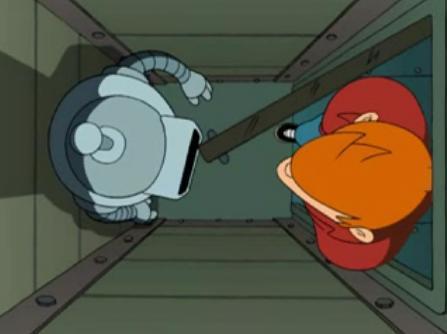
Scalzi hints at this when he talks about rental properties for Hadens, which are basically closets where their threeps can recharge. (I imagined these as being like Bender’s apartment in Futurama.) But those properties are for the threeps. Where are the bodies?
I don’t know for certain, but I bet they’re in nursing homes, or something worse than nursing homes. I mean, think about it from the perspective of a Medicaid administrator. (You may want to take a shower after you do this.) You have a greatly increased number of patients who need around-the-clock care and monitoring. What’s the cheapest way to do that? Answer: fill up old and disused facilities with Haden patients. The patients are all locked in, so you don’t need to have programming for them, or feed them anything but sludge, or provide clothes or counseling or even sunlight. It would be like The Matrix, but instead of using the patients as batteries you’d use them to collect federal Medicaid dollars. Tell me your average state Medicaid administrator wouldn’t do this in a second. (I would say “in a heartbeat” but, well.)
There are two competing orthodoxies in disability policy. One is the “civil rights model,” which says that people with disabilities are people and have the right to be free and independent and not to experience discrimination, and sometimes discrimination comes in the form of a stairway or a doorknob or a toilet paper dispenser that’s three inches too high. Then there’s the “medical model,” which says that you have a disability if you meet a certain medical criteria, and if you do, we’re going to do our best to cure you, and if we can’t, well, that’s too bad, here’s some federal benefits and maybe a job at a sheltered workshop or something. What you have in Locked In, largely, is a situation where the civil rights model is ascendant, but only for people who have both a threep and the resources to arrange home care. It doesn’t say what happens to everyone else under the medical model. I don’t think that was good to start off with, and with the severe budget cuts Scalzi describes, it might get worse.
(Oh, and if you don’t think that the mass institutionalization of a large disability subset is ipso facto horrifying, you have my permission to visit a large state psychiatric hospital sometime. Please. I’ll hold the door open for you and everything.)
Does Scalzi do a fine job of having a heroic protagonist with a serious disability? Yes, unreservedly. But the only major Haden characters in the book are Chris, a diabolical billionaire and his lackey attorney, a software engineer, a doctor, and a political leader. Maybe that’s not the top 1% of Hadens, but it’s telling that there’s not a representative character who’s in the 99%. I think Lock In handles the disability issues in the book with sensitivity, but it’s clearly not telling the whole story.
Horrifying Scenario #3: The Sexual Aspect
Scalzi goes to great lengths to keep the question of whether Chris Shane is male or female open, going so far as to say that “I personally don’t know Chris’s gender.” I am not going to speculate here on why he made that particular choice. I think it’s simultaneously kind of brilliant and kind of screwy, which is mostly meant as a compliment. I am OK with it in that I think that it’s an idea that progresses naturally from the premises of the novel, as Chris presents to the world as a non-gendered threep. I have very mixed feelings from the disability perspective, as there’s already a social stigma about talking about disability and sexuality together. I dislike that you have a heroic protagonist with a disability who is also genderless–I think that’s problematic.
What’s even more problematic is that Scalzi never, not even once, talks about Haden sexuality.
One of the characters in Lock In is a former Integrator, and according to her, what Haden patients typically do, when they are integrated with an Integrator for the first time, is go to Five Guys and get a bacon double cheeseburger.
Now, look. I have nothing against the bacon double cheeseburger from Five Guys. I’d like one myself right about now. I’m from Texas, so I’d rather have a Whataburger, but to each his own. I just don’t think that would be everyone’s first choice. (Even from a gustatory perspective, I’d rather have Texas sheet cake and homemade vanilla ice cream.)
How many people, do you think, would hire an Integrator in order to have sex with their significant others? Or, you know, themselves?
I know what you’re thinking, because I am thinking it too, and I am thinking SQUICK SQUICK SQUICK SQUICK SQUICK. It’s okay. Take a deep breath.
Because I haven’t even gotten to the whole part about robot sex.
SQUICK SQUICK SQUICK SQUICK SQUICK.
OKAY. Calm down.
Look. There are a lot of different sexual scenarios that could, conceivably, come to mind in this particular universe. I think that there is some wisdom, from an authorial perspective, to not exploring them, to leaving them unsaid. (I will point out that Scalzi has had no problem with exploring the group-sex implications of his fictional universe in the Old Man’s War books.) But by making Chris essentially genderless, Scalzi effectively walls himself off from any discussion of Haden sexuality. (Or, to put it another way, he leaves it to the devices of the masses of fan-fiction writers. Squick.)
Horrifying Scenario #4: The Plague Years
Scalzi just happens to mention, at one point, that people are still getting lock-in, all the time, although not at the levels that were happening at the height of the epidemic. Meanwhile, you never see anyone, you know, wearing a surgical mask, or slathering themselves with Purell, or refusing to go outside, or generally behaving how people would behave if they thought they could catch the Haden flu and be locked in their bodies for the rest of their lives.
I am just throwing this out there.
I know why you have to have normal people running around doing normal things, because otherwise there wouldn’t be a story, but still. You’d think that people would be, you know, a little afraid of catching the flu in this universe. It’s already a paranoid thriller, you’d think that would amp it up a bit.
Horrifying Scenario #5: The Brain Hack
There’s a scene in Lock In where Chris sits in his/her Bat Cave (no, really), as he/she considers all the different suspects in his multiple murder case, and narrows them down to either an influential community organizer or a powerful billionaire titan of industry bent on cornering the market for Haden services.
Who do you think the killer is?
Go on, guess.
You’ll never guess.
Wow! You guessed right. It was the evil billionaire! How did you ever figure that out?
(Okay, I’m done now.)
This is the horrifying scenario that Lock In spends the most of its time exploring. Can evil billionaires hack your brain and turn you into a zombie assassin? The answer is yes. The problem is that (at the time of the novel) it’s incredibly expensive, and very much an emerging technology, and it’s just as easy to use an Integrator to shoot whoever you want shot. So there’s that.
What else can the technology do? Maybe you don’t want to turn your army of hacked Integrators and threeps into zombie assassins. Maybe you want them all to move to Delaware and vote for you for the open Senate seat. Maybe you want to hack their brains to play the Meow Mix jingle constantly in their brains until they commit suicide. Maybe you want to go seriously old-school Othello and convince someone that their wife is cheating on them until the point where he decides to murder her.
Anyway, point is, lots of things you can do if you can hack into someone’s brain. Including making them write very long blog posts that aren’t book reviews, instead of writing a new novel. Hey, wait.
The Less-Horrifying Conclusion
Lock In is a lot of fun to read and has at least one memorable character in Chris’s partner, who is Lynchian but the wrong kind (Jane and not David). It reads much better as a near-term science-fiction drama (a genre where it excels) than it does as a police procedural (where it largely falls flat). You should read it, and if you’ve read this far, you already have. It has cool zombie assassins and ninja robots. And it makes you think deeply about what the implications of new technology, both medical and robotical, might be for our own future, to the point of writing a long blog post about it that very few people will read. These are all good things, and it is to Scalzi’s credit that he produced a novel that generates such good things.
January 8, 2015
In Every Life A Little Reign Must Fall
To “rein in” a horse means to pull on its reins, causing it to slow down. So the phrase is “rein it in” — NOT “reign it in.” If you’re reining something in, you’re doing to it what a rider would do to a runaway horse.
Grammar Rant of the Day, March 4, 2014.
SeBour, a member of the board of directors for the Arbutus Business and Professional Association, said the organization discussed encouraging private investment in Arbutus, but didn’t have anyone to take the reigns.
Baltimore Sun, January 7, 2015.
Two weeks ago, Meehan was appointed to Governor-elect Charlie Baker’s transition team to oversee educational issues. At the same time, Caret announced his departure at the end of January to take the reigns of the University of Maryland college system.
Lowell Sun, January 7, 2015.
But perhaps Mother Nature was giving Jodie Marsh a hint that she should reign it in a little.
Daily Mail, January 6, 2015.
I have tons of ideas flying into my head all of the time – that’s what happens when you’re ADD. You’re hyperactive and all over the place, but you can also sit for eight-hour stretches if you’re really interested in something. I can reign it in and control it. I’ve also found ways to cope with things that distract me.
Publisher’s Weekly, January 6, 2015.
ICYMI, “Pitch Perfect” star Rebel Wilson crushed it when she hosted the MTV Movie Awards back in April of 2013. This year, another hilarious blond lady will take the reigns, so when MTV UK caught up with Wilson when she was out promoting “Night at the Museum: Secret of the Tomb,” we just had to find out if she had any advice for Amy Schumer. (She does.)
MTV News, January 6, 2015.
Sources tell News4 Jack Requa, Metro’s assistant general manager, will be asked to take the reigns as acting GM. The announcement is expected at Thursday’s board meeting.
NBC 4 Washington, January 5, 2015.
With Republicans set to take over both chambers of Congress on Tuesday, syndicated columnist Charles Krauthammer said on “The O’Reilly Factor” Monday he cannot wait for the GOP to take the reigns and show that “the grown-ups are now in control.”
Daily Caller, January 5, 2015.
What to Watch: After an admittedly dramatic offseason, the Jaspers are trying to find some consistency on the court this winter but it hasn’t always been easy. Manhattan needs to reign it in a little bit.
The Saratogian, January 1, 2015.
“The President has expressed full confidence in Director Brennan and demonstrated that trust by making no effort at all to reign it in,” Udall said.
WDAM.com, December 17, 2014.
Inhofe is set to take over the Senate Environment and Public Works Committee when the new Republicans take over the Senate in January. This committee is a key player in regulating the Environmental Protection Agency (EPA) and trying to reign it in.
Mashable, November 12, 2014.
Using “rein” instead of “reign” is not difficult, people. It just isn’t. Make this a priority, please, before I have to come and slap you.



